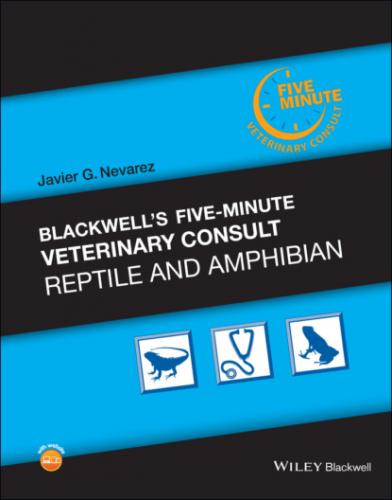COMMENTS
N/A
ZOONOTIC POTENTIAL
High host‐specificity. No known zoonotic risk with any Eimeria species.
SYNONYMS
N/A
ABBREVIATIONS
GI = gastrointestinal
K2Cr2O7 = potassium dichromate
PCR = polymerase chain reaction
w/v = weight by volume
Suggested Reading
1 Gibbons PM. Advances in reptile clinical therapeutics. J Exot Pet Med 2014;23(1):21–38.
2 Helke KL, Cooper TK, Mankowski JL, Poynton SL. Disseminated visceral coccidi-
3 osis in Indo‐gangetic flap‐shelled turtles, Lissemys punctata andersonii. J Wildl Dis 2006;42(4):788–796.
4 Jacobson ER. Parasites and parasitic diseases of reptiles. In: Jacobson ER, ed. Infectious Diseases and Pathology of Reptiles: Color Atlas and Text. Boca Raton, FL: CRC Press; 2007:571–665.
5 Scullion FT, Scullion MG. Gastrointestinal protozoal diseases in reptiles. J Exot Pet Med 2009;18(4):266–278.
6 Vetterling JM, Widmer EA. Eimeria cascabeli sp. n. (Eimeriidae, Sporozoa) from rattlesnakes, with a review of the species of Eimeria from snakes. J Parasitol 1968;54(3):569–576.
Author T. Franciscus Scheelings, BVSc, MVSc, PhD, MANCVSc (Wildlife Health), DECZM (Herpetology)
Entamoeba
DEFINITION/OVERVIEW
Entamoeba are characterized into two groupings based on morphology. The two groupings are based on the number of nuclei present. Entamoeba spp. in the group containing four nuclei are considered to be pathogenic and the main concern for reptilian species. Entamoeba spp. in the group containing eight nuclei are considered to be noninvasive. E. invadens is the most common pathogenic species seen in reptiles and has been known to cause significant mortality. Virulence can differ between strains of E. invadens; infectious cysts are 11–20.2 μm with four nuclei and a small central karyosome. Trophozoites are 17.5–50 μm in length (average 36.18 μm), 10–25 μm (average 12 μm) in width and average diameter of 24.1 μm. Trophozoites also possess a single nuclei with a large central karysome that is 5–7.5 μm (average 5.65 μm) in diameter.
ETIOLOGY/PATHOPHYSIOLOGY
E. invadens has a direct life cycle and transmission is through the fecal–oral route.
Cysts are ingested and then undergo excystation in the intestinal tract.
In chelonians, cyst production occurs by cell division and one metacystic form gives rise to eight amoebas.
E. invadens mainly inhabits the small and large intestines but can affect other adjacent organs, including the liver, kidneys, pancreas, and lungs via systemic circulation.
The motile feeding trophozoite can also encyst and then be passed through the host’s GI tract and out in the feces.
Trophozoites undergo encystation in which infective cysts are formed and then excreted in feces.
Cysts can remain infective for 14+ days at temperatures of 8 degrees C and several days at 37 degrees C.
It was first considered that chelonians were only carriers and E. invadens were commensal parasites, but there is sufficient evidence that the parasite can affect and cause mortality in all chelonians, including terrestrial chelonians, freshwater and sea turtles.
The disease process causes severe necrotizing colitis, hepatic and pancreatic necrosis with associated granulomas.
Clinical signs occur approximately 2–10 weeks prior to death.
SIGNALMENT/HISTORY
All ages can be affected. Animals consistently kept in temperatures between 25–33 degrees C.
Carnivorous chelonians appear to be more susceptible versus herbivorous chelonians.
Herbivorous chelonians can be asymptomatic carriers.
CLINICAL PRESENTATION
Anorexia
Diarrhea
Dehydration
Weight loss
Bloody and mucoid stools
Hardening of the large intestinal tract that can be palpated.
Intussusception
Vomiting
Sudden death
RISK FACTORS
Husbandry
Improper husbandry and hygiene, diarrhea, housed with infected animals, decreased immune status, temperatures held between 25 and 33 degrees C.
Invertebrates (i.e., roaches and flies) act as mechanical vectors.
Others
N/A
DIFFERENTIAL DIAGNOSIS
Salmonellosis
GI helminths
DIAGNOSTICS
Microscopic evaluation of fresh fecal material to visualize trophozoites and cysts.
Trophozoites may be seen in fresh fecal but die rapidly within 20–30 minutes once outside the host.
SAF technique can be used for better visualization.
Fecal/cysts can be placed within a petri dish with water and trophozoites will emerge from the dissolved envelope within several hours.
Immunohistochemistry with E. invadens poly clonal antibody is developed for snakes.
Polymerase chain reaction assays can be used to distinguish species of Entamoeba.
PATHOLOGICAL FINDINGS
Gross changes include thickening, edema, erosions, ulcers, and diphtheritic membranes of the large intestine.
Liver
